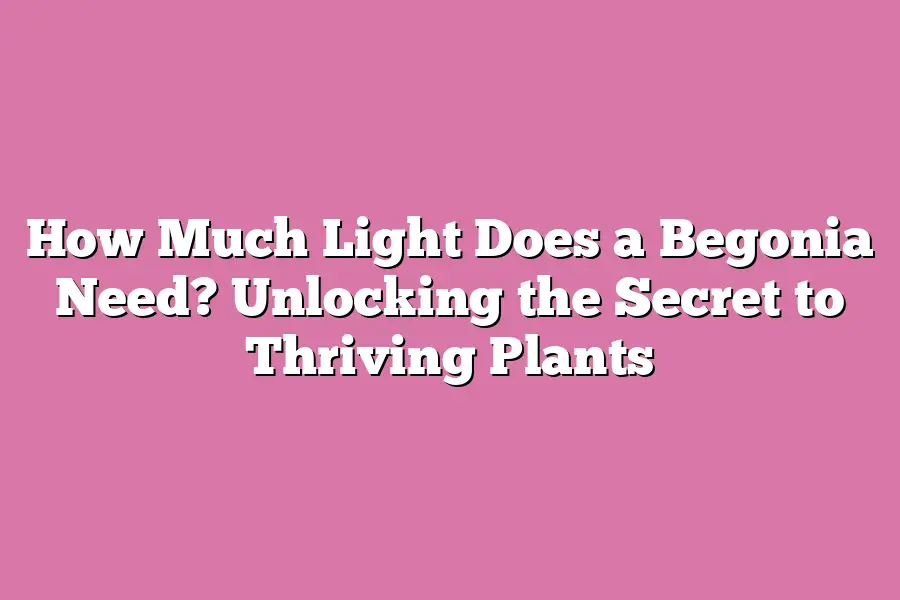Begonias typically require bright, indirect light to thrive. A south-facing window with a sheer curtain or a grow light can provide the right amount of light for these plants. Direct sunlight can cause leaf scorch, so it’s best to keep them at least 3-4 feet away from direct sun rays. Aim for 10-12 hours of bright, indirect light per day.
As a passionate gardener, I’ve always been fascinated by the Begonia family.
These stunning plants have captured my heart with their vibrant blooms and velvety leaves.
But one question has long plagued me: how much light does a Begonia need to truly thrive?
For years, I’ve experimented with different lighting conditions, observing the subtle yet significant impact it has on these beautiful flowers.
In this article, I’ll share my findings and expert insights on unlocking the secret to thriving plants – so you can bring out the best in your own Begonias.
Whether you’re a seasoned green thumb or just starting out, get ready to illuminate your understanding of Begonia care and take your plant parenting skills to the next level!
Table of Contents
Light Requirements for Begonias: Unlocking the Secret to Thriving Plants
When it comes to giving your begonias the TLC they need, one of the most crucial factors is lighting.
But let me ask you, have you ever wondered what kind of light your beloved begonia really needs?
Are you providing enough, or maybe even too much?
As a seasoned plant parent, I’m here to give you the lowdown on the different types of begonias and their unique lighting requirements.
From rhizomatous to tuberous, each type has its own specific needs.
Rhizomatous Begonias: The Bright Light Brigade
These guys are all about brightness!
Rhizomatous begonias thrive in bright indirect light, which means they need a gentle stream of sunlight that’s filtered through a curtain or a sheer blind.
If you expose them to direct sunlight, they’ll start stretching towards the light source, losing their compact shape and potentially becoming leggy.
Tuberous Begonias: The High-Intensity Heroes
Now, if you’re looking for optimal flowering from your tuberous begonias, you’ll need to crank up the lights!
These beauties require high-intensity light to produce those stunning blooms.
Imagine a sunny windowsill with plenty of natural light – that’s what they’re looking for.
Semperflorens Begonias: The Happy Medium
Semperflorens begonias are like the Goldilocks of the plant world – they need their lighting “just right.” Not too bright, not too dim, but just enough to keep them happy and healthy.
Think of it as a gentle, warm glow that’s perfect for a sunny corner or a south-facing window.
The Factors That Affect Light Requirements
Now that we’ve covered the different types of begonias, let’s talk about what can affect their light requirements.
You see, temperature, humidity, and soil type can all impact how much light your begonias need.
For example, did you know that a change in temperature can significantly impact light requirements?
Let me share a case study with you:
Case Study: How Temperature Affects Light Requirements
Imagine you’re growing rhizomatous begonias in a warm, cozy room with a consistent temperature around 75°F (24°C).
Everything’s going great – they’re getting plenty of bright indirect light and thriving.
But then, you decide to move them to an air-conditioned space with a much cooler temperature, say around 60°F (16°C).
What happens?
Your begonias start stretching towards the light again!
Why?
Because the lower temperature has triggered a natural response in the plant to reach for more light.
It’s like they’re saying, “Hey, I need more warmth and light to compensate for this cooler environment!”
By understanding how factors like temperature, humidity, and soil type affect your begonias’ light requirements, you can make adjustments to create the perfect environment for them to flourish.
And that’s it!
With these tips and tricks, you’ll be well on your way to unlocking the secret to thriving begonias.
Happy planting!
Understanding Light Intensity and Duration: The Key to Begonia Bliss
As a plant enthusiast, you want your begonias to thrive – but how much light do they really need?
It’s a question that has puzzled even the most seasoned green thumbs.
In this section, we’ll dive into the world of light intensity and duration, exploring what works best for these stunning plants.
What is Light Intensity?
When it comes to begonias, light intensity is a crucial factor in their growth and development.
Measured in foot-candles (fc), light intensity refers to the amount of light that reaches your plant’s leaves.
To put it simply: more intense light means more energy for your plants.
For begonias, a general rule of thumb is to provide them with 1-2 fc of direct sunlight or 10-20 fc of indirect sunlight.
But what does this mean in real terms?
Imagine standing outside on a sunny day – that’s roughly the intensity we’re talking about!
In contrast, indoor lighting might be around 0.5-1 fc.
The Importance of Light Intensity
So why is light intensity so vital for begonias?
Well, it’s all about photosynthesis – the process by which plants convert sunlight into energy.
With insufficient light, your begonias may become leggy or weak, while excessive light can cause scorching or burning.
Morning Sun vs. Afternoon Sun: Which is Best for Begonias?
Now that we’ve covered the importance of light intensity, let’s talk about duration – specifically, morning sun versus afternoon sun.
Both periods have their advantages and disadvantages when it comes to begonias.
Morning sunlight tends to be more gentle, with a slightly cooler temperature and less intense UV rays.
This can be beneficial for begonias, especially if they’re sensitive to direct midday sun.
On the other hand, afternoon sun is often more intense, providing a boost of energy for your plants as the day winds down.
If I had to choose, I’d recommend morning sunlight for most begonia varieties – but it ultimately comes down to your specific plant’s needs and preferences!
Artificial Lighting Options: LED Grow Lights and More
What about artificial lighting options?
While natural light is always preferred, there are times when you may need to supplement with grow lights.
LED grow lights, in particular, have become increasingly popular for indoor gardening.
These energy-efficient lights provide a tailored spectrum of light that can mimic the sun’s rays, promoting healthy growth and development.
Some benefits include:
- Energy efficiency: LED grow lights consume significantly less power than traditional lighting options
- Customization: Many LED grow lights allow you to adjust the intensity, color temperature, and spectral range for optimal results
- Space-saving design: Compact LED grow lights are perfect for small gardens or indoor spaces
Other artificial lighting options include fluorescent lights, which can also be used for begonias.
When choosing a light source, consider factors like color temperature, lumens per watt, and the specific needs of your plants.
In conclusion, understanding light intensity and duration is crucial for nurturing happy and healthy begonias.
By providing the right amount of direct or indirect sunlight, you’ll set your plants up for success – whether that’s through morning sun, afternoon sun, or artificial lighting options.
With this knowledge, you’re ready to unlock the secret to thriving plants and enjoy a beautiful begonia-filled space!
Tips for Providing Optimal Lighting for Begonias
As a begonia enthusiast, you’re probably eager to learn how to create the perfect lighting conditions for these stunning plants.
But let me tell you, it’s not just about throwing some light their way – it’s an art!
In this section, I’ll share my top tips on how to provide optimal lighting for begonias that will make them thrive.
Placing Plants Near Windows or Using Skylights
I know what you’re thinking – “Why can’t I just stick my begonia in a sunny windowsill and call it a day?” Well, yes and no.
While direct sunlight can be beneficial, it’s essential to consider the intensity of the light and the direction it’s coming from.
Begonias love bright, indirect light, but they can get scorched if exposed to too much direct sunlight.
That’s why I recommend placing your begonia near a window with sheer curtains or using skylights that diffuse the natural light.
This will provide your plant with a gentle, even glow that it’ll adore.
Just make sure to rotate your plant every few days to prevent uneven growth – more on that later!
Using Grow Lights and Adjusting Their Distance
Sometimes, natural light just isn’t enough, especially during those long winter months or in rooms without many windows.
That’s where grow lights come in!
These amazing tools can provide your begonia with the right amount of light it needs to photosynthesize and grow strong.
Now, here’s the thing – you don’t want to blast your plant with too much artificial light either.
Begonias prefer gentle, diffused light, so make sure to adjust the distance between the light source and your plant.
A good rule of thumb is to start with a lower intensity and gradually increase it as needed.
Rotating Plants for Even Light Distribution
This might seem like a no-brainer, but trust me, it’s crucial!
Begonias can grow quite tall and sprawling, which means they need even light distribution to prevent lopsided growth.
By rotating your plant every few days, you’ll ensure that all parts of the leaf get the same amount of light.
It’s also essential to keep an eye on the direction of the light source and adjust accordingly.
For example, if you’re using a grow light with a directional beam, make sure to rotate your plant so it gets equal exposure from both sides.
There you have it – my top tips for providing optimal lighting for begonias!
By following these simple steps, you’ll be well on your way to growing happy, healthy plants that will thrive under the right conditions.
Happy planting!
Final Thoughts
As I wrap up this exploration of how much light does a begonia need, it’s clear that these stunning plants are more than just pretty faces.
By understanding their unique lighting requirements and adapting our care strategies accordingly, we can unlock the secret to thriving begonias that will brighten up any room.
In reality, providing optimal lighting for begonias is all about striking the right balance between light intensity and duration.
Whether you’re working with morning sun or artificial grow lights, it’s crucial to consider factors like temperature, humidity, and soil type when creating a customized lighting plan.
So, go ahead and give your begonias the gift of perfect lighting – I promise you’ll be rewarded with robust growth, vibrant colors, and a whole lot of joy.
Happy planting!

